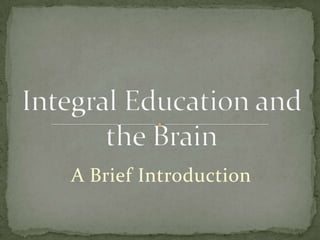
Integral Education and the Brain; A very very brief introduction
- 2. “In fact, at this point in history, the most radical, pervasive, and earth-shaking transformation would occur simply if everybody truly evolved to a mature, rational, and responsible ego, capable of freely participating in the open exchange of mutual self-esteem. There is the "edge of history." There would be a real New Age.” -Up From Eden (1981) “But every approach, I honestly believe, is essentially true but partial, true but partial, true but partial. And on my own tombstone, I dearly hope that someday they will write: He was true but partial...” - Introduction, Collected Works of Ken Wilber, vol. VIII (2000)
- 3. Draws from a broad array of mainstream, alternative and trans-disciplinary sources of knowledge Explores multiple perspectives and avoids splitting issues into simple binaries Invites an awareness of paradoxes and the truths and insights that come from each of these perspectives. Integral education acknowledges that each perspective has something to offer to the greater tapestry of any subject of knowledge
- 4. Includes first, second and third person methodologies of learning, teaching and expression. Includes subjective, inter-subjective and objective realities an example of which would be artistic expression, collaborative work, personal participatory inquiry, and empirical analysis. Both critical thinking and ones experiential feelings are honored and incorporated. Inclusion of the exploration of the self, cultures and nature, not as separate islands of experience but as interdependent aspects of conscious life in a complex web of ecosystems.
- 7. (Esbjorn-Hargens, Reams, & Gunnlaugson, 2010, p.64).
- 8. (Esbjorn-Hargens, Reams, & Gunnlaugson, 2010, p.65).
- 9. To give an individual direction to the process of Integral education we begin by looking at Levels or Stages of development. “Including the insights from constructive- developmental psychology: We see a central role for developmental approaches that recognizes that individuals—students and teachers—are at different stages of growth in their personal and educational journeys. The more we can inform our classrooms by these insights the more contexts we can provide to engage with this vital transformative potential” (Esbjorn-Hargens, Reams, & Gunnlaugson, 2010, p.10).
- 11. (Wikipedia)
- 13. “This realm of the human being is educated then by creative art, by nuanced understanding of psychology, and by aware focus on the feeling realm of the human being. These realms may incidentally be included in mainstream educational strategies, but they are not comprehensively engaged. The hope here would be for a refined, sensitive, and powerfully moral human being to emerge from ‘vital education’” (Esbjorn-Hargens, Reams, & Gunnlaugson, 2010, p.51)
- 15. Linda Olds (1992), as a psychologist and system theorist argues that all knowledge has a relationship to the physical domain of the body. “Our knowledge from its onset is also embodied, embedded in our kinesthetic relationship with reality and in the connection of our bodies to the physical world. Our bodily based experience of moving and interacting in the world impacts our ability to understand our world as much as our abstract intellectual thinking” (p. 8)
- 16. We know from research on neuroplasticity that the brain is built to change in response to experiences (Davidson, 2000). As a student goes through life the brain is constantly being shaped and influenced, and the classroom is an ideal place to help students make positive neural connections: “Neuroplasticity means that the sculpting of the brain’s circuitry during this period of brain growth depends to a great degree on what a child experiences day to day” (Lantieri, 2008, p. 2).
- 18. Gathering information (sensory cortex), Making meaning from that information (back integrative cortex), Creating new ideas from those meanings (front integrative cortex) Acting on these new ideas (motor cortex). From these four basic functions he labels four pillars of learning: gathering, analyzing, creating, and acting (Zull).
- 21. As Zull says, “That seems to mean two things: first, the learning itself must evoke emotion, and second, it must be about things which naturally engage the learner. For the process of learning, extrinsic motivators, such as grades or gold stars, are only needed when these intrinsic conditions are not met. If the learner is given assignments that connect with things which naturally interest her, and if she finds the learning itself rewarding, if she makes progress, extrinsic rewards are not needed” (Zull). If we are able to bring in fully functioning integral education then it would naturally engage an individual learner, since it would necessitate taking into account their emotional and intellectual learning needs.
- 22. Cook-Greuter, S. R. (2005). AQ as a scanning and mapping device. AQAL: Journal of Integral Theory and Practice, 1(3), 1–17. Davidson, R. J. (2000). Affective style, psychopathology, and resilience: Brain mechanisms and plasticity. American Psychologist, 55(11), 1196–1214. Dea, W. (2011). Igniting brilliance; integral education for the 21st century. Tucson, Az: Integral Publishers. Esbjorn-Hargens, S., Reams, J., & Gunnlaugson, O. (2010). Integral education; new directions for higher learning. Albany, NY: SUNY Press. Geake, J. (2009). The brain at school; educational neuroscience in the classroom. Berkshire, England: Open University Press. Goleman, D., Bennet, L., & Barlow, Z. (2012). Ecoliterate: how educators are cultivating emotional, social, and ecological intelligence. San Francisco, CA: Jossy-Bass.
- 23. Lantieri, L. (2008). Building emotional intelligence: Techniques to cultivate inner strength in children. Bolder, CO: Sounds True. Martin Haigh (2013). AQAL Integral: a holistic framework for pedagogic research, Journal of Geography in Higher Education, 37:2, 174-191. Mooney, C. (2000). Theories of childhood; an introduction to dewey, montessori, erikson, piaget, and vygotsky. (2nd ed.). St. Paul, MN: Redleaf Press. Olds, L. (1992). Metaphors of interrelatedness. Albany, NY: SUNY Press. Wilber, K., (2006). Integral spirituality: A startling new role for religion in the modern and postmodern world. Boston: Shambhala. Zull, J. (n.d.). The art of the changing brain. Retrieved from http://education.jhu.edu/PD/newhorizons/Neurosciences/articles/Th e Art of the Changing Brain/index.html
Notas do Editor
- (Haigh, 2013, p.175)
